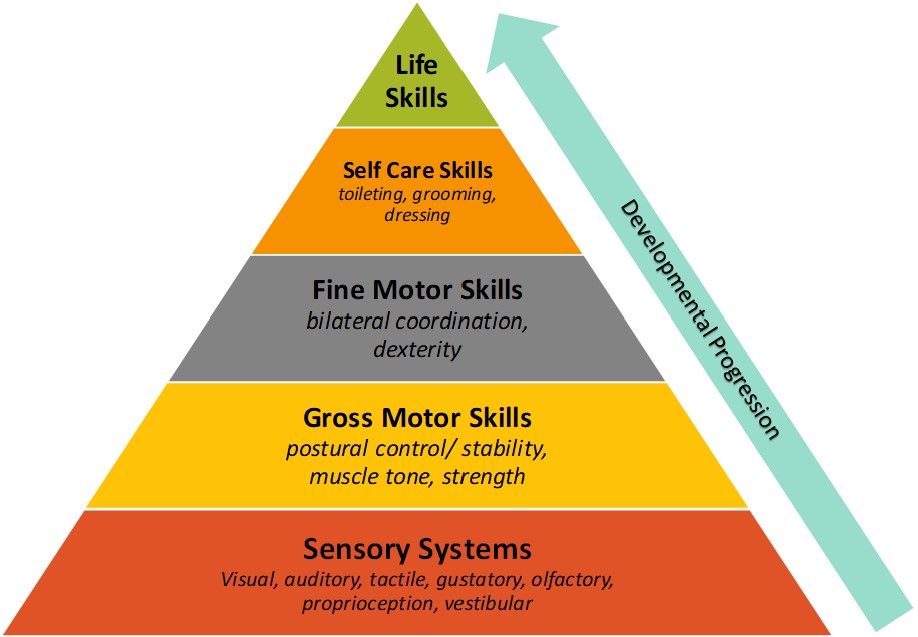Fine Motor Development
Fine motor skills refer to performing functional tasks through small movements of the hands, wrists, and fingers, and include activities such as:
- Drawing and printing
- Cutting with scissors
- Working with fasteners, such as buttons or zippers
- Eating with utensils

The building blocks of fine motor development are:
- Tactile perception
- Postural control
- Bilateral coordination
- Dexterity
Tactile Perception
Tactile perception involves sensory receptors sending information to the brain about what we are feeling and touching. This includes light touch, pressure, vibration, temperature, and pain. Touch sensation enables us to feel things and understand what we feel, making it an important component of fine motor development. Tactile perception helps children guide their finger movements so that fine motor skills can be more automatic. If a child is not getting adequate sensory feedback from their hands and fingers, accuracy can be challenging. Difficulties with tactile perception can manifest in different ways. For example, a child may appear clumsy and have difficulty holding small objects without dropping them. They may also squeeze writing tools very tightly so they can “feel them more”.
Postural Control
Postural control refers to our ability to sustain an upright position for sitting, standing, and performing functional tasks. Low muscle tone, decreased strength and hypermobility (prevalent in children with Down syndrome) reduce postural control. For children with Down syndrome, these physical factors make it more difficult to stabilize to meet the demands of an activity. A stable base of support allows one to coordinate the effective movement of the arms, hands, and fingers. Postural control is important for effective writing, drawing, and cutting skills. It also supports us in sitting upright in a chair, sitting cross-legged on the floor, and using an appropriate amount of pressure when holding a pencil and pressing down on paper. A child with poor postural control will fatigue more efficiently, as their muscles work harder to keep them upright. This is why supported seating is central to facilitating fine motor skills for children with Down syndrome (see positioning handout below in DSRF resources).
Bilateral Coordination
Bilateral coordination refers to the ability to coordinate both sides of the body simultaneously in a controlled and organized manner. Stabilizing paper with one hand while writing/cutting with the other is an example. Good bilateral integration/coordination indicates that both sides of the brain are communicating effectively and sharing information. This supports an awareness of the two sides of the body, selection of one side as dominant, and the ability to discriminate between our left and right sides. The developmental trajectory of bilateral coordination generally progresses through the following stages:
- Gross Symmetric Bilateral Skills – holding objects with two hands, clapping, banging things together
- Stabilizing object(s) with one hand while manipulating with the other, like holding a container with one hand while putting something in it with the other
- Complementary two hand use where objects are manipulated with both hands simultaneously
Dexterity
Dexterity refers to skillful, precise, and efficient hand movements. It is important for functional tasks such as dressing, feeding, and school-related activities (i.e. printing, coloring, and cutting). It comes into play in several ways:
- Grasp (pencil or utensil use)
- Finger control and coordination
- Hand and wrist movements
- The muscles of the hands need to manipulate small things effectively. They also need to have enough strength to grasp objects. Being able to rotate the wrist is important for positioning the hand for functional skills, such as writing and drawing
At DSRF, occupational therapy can assist your child with developing the fine motor skills required to participate in their day to day activities, including in the areas of self-care (i.e. dressing, grooming, feeding), productivity (i.e. printing, cutting, typing) and leisure (i.e. play with puzzles, toys, video games).
DSRF Resources
Strategies to Support Children with Down Syndrome in the Classroom
Video: Motor Development and the Importance of Positioning
Other Resources
Fine Motor Skills for Children with Down syndrome: A Guide for Parents and Professionals, by Maryanne Bruni
